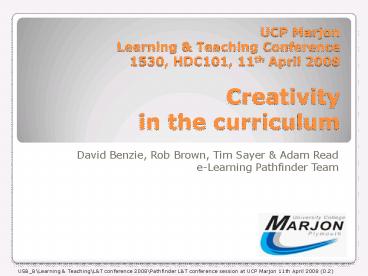UCP Marjon Learning - PowerPoint PPT Presentation
1 / 16
Title:
UCP Marjon Learning
Description:
Developing an eLS. E-Learning Strategy. Development. Informed by. HEA ... This digital story used standard web/digital camera photos and audio recorded ... – PowerPoint PPT presentation
Number of Views:69
Avg rating:3.0/5.0
Title: UCP Marjon Learning
1
UCP MarjonLearning Teaching Conference1530,
HDC101, 11th April 2008 Creativityin the
curriculum
- David Benzie, Rob Brown, Tim Sayer Adam Read
- e-Learning Pathfinder Team
USB_B\Learning Teaching\LT conference
2008\Pathfinder LT conference session at UCP
Marjon 11th April 2008 (0.2)
2
Overview
- Staff Student surveys (Autumn 2008)
- New e-Learning Strategy
- Examples to help you think creativelya)
Creating on-line culturesb) Direct input
podcasting lecturesc) Using Wikis on LS
3
Staff Student surveys
- Some key messages
- Most staff regularly use ICT in their teaching
- butmostly for PowerPoint, resource provision and
straight-forward communication (e.g. e-mail or
making announcements)
4
Staff Student surveys
- Some (more) key messages
- Staff student reactions to the Bb VLE differ
markedly students more positive higher levels
of use. - VLE contains little-used functions students want
staff to make more use of Bb - Need major awareness, training and support
programme for staff
5
Developing an eLS
- E-Learning Strategy
- Development
- Informed by
- HEA Benchmarking Project
- Staff student surveys
- Staff Conference - Easter 2007
- Other institutional strategies
6
Key perspective on learning
- Social constructivism is a common shorthand
- for the leading perspective on learning
- Learning is a social activity
- Learners actively construct new knowledge and
understanding through collaborative activity with
peers and knowledgeable others - Diligent independent activity by learners is
valued
7
Alias-C Active Learners in a supportive community
Access to resources Flexible
learningopportunities Links to
othercommunities
ICT infrastructure Data reginfrastructure
Support from staff
8
Full text of eLS action plan
- The full text of the new e-Learning Strategy and
the associated action plan is in LSLSgtLS Staff
Supportgte-Learning
9
Examples
- Examples to help you think creatively
- Creating on-line cultures
- Direct input pod-casting lectures
- Using Wikis in LearningSpace
10
Engaging students in eLearning
- Creating an on-line culture
- Make it part of the assessment
- Provide one question/discussion point per week
that students have to contribute to - Provide a blog space for students and get them
to engage in reflective practice - Useful for project work.
- Provide an space to build a knowledge base that
students must contribute to
11
Interactive Teaching Tools
- Engaging students in eLearning
- Provide content not necessarily directly related
to their modules - Empower students to be able to own the site or
parts of the site - Embed as much as possible within the page,
minimizing downloads and minimizing clicks to
access and participate
12
Podcasts
- A digital story!...
- See http//www.ucpmarjon.ac.uk/research/pathfinder
project/documents/ - Important
- Both podcasts and digital stories can be
low-tech! - This digital story used standard web/digital
camera photos and audio recorded using a basic PC
mic and some free software.
13
Wikis
- A wiki is a piece of software that allows users
to add and edit the content of a website. - High profile example is Wikipedia an
encyclopaedia wiki! - Staff and students can use wikis in their study
module or group areas on LearningSpace.
14
Wikis
- Wikis can be used to encourage group
collaboration (active users engaging content). - Some possible uses are
- Student group work
- Student knowledge base
- Staff knowledge base
- FAQs
- Displaying course materials in more interactive
way.
15
Wikis
- Some techie info
- Each wiki page can be edited by members.
- Members can add or update content from any number
of pages. - Staff can control who the members are.
- Each time a page is saved, a new version is
created. - It is possible to look back over previous
versions and roll back. - Staff can keep track of student participation.
Very important for group work!
16
Wikis...
- Examples
- Adam student assignment, group work.
- Rob another example course documents and
notes. - Look out for
- Blackboard Sync a Facebook application to
integrate LS course information into Facebook!






























